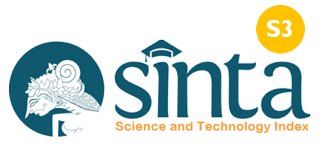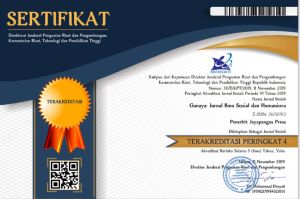Kontekstualisasi Nilai-Nilai Adat Toana Dalam Pembelajaran Sejarah (Studi pada Siswa SMA Negeri 10 Kota Pontianak)
DOI:
https://doi.org/10.37329/cetta.v5i1.1458Keywords:
Contextualization, History Learning, Toana CustomsAbstract
Adat Toana is part of the historiography of the Mempawah Kingdom where the values in Adat Toana describe the heterogeneous character and characteristics of the Mempawah community, this can be a contextual history learning material for students because it can link the past and its causality for the present. This study aims to (1) what are the values in Adat Toana (2) how to contextualize Adat Toana in learning history. This study uses a qualitative approach with a descriptive study. Data obtained from observations, interviews and documentation studies. The results of this study indicate that Adat Toana has cultural, social and historical values. In teaching the teacher has linked the material of the Indigenous Toana tradition with the material in the textbook, contextualization is carried out by bringing up the narrative of ethnic diversity in Mempawah and the history of the Toana Tradition in Karyaaan Mempawah. Contextualization produces feedback in the form of student responses to the importance of maintaining unity in differences, besides contextualization is oriented towards growing love for local culture.
References
Ahmad Adaby, D. (1997). Sejarah Lisan Memburu Sumber Sejarah dari Para Pelaku dan Penyaksi Sejarah. Jurnal Humaniora, IV.
Carr, E. H. (1982). What is History. Alfred A Knopt.
Elaine B, J. (2002). Contextual Teaching and Learning: Menjadikan Kegiatan Belajar-Mengajar Mengasyikan dan Bermakna. Kaifa.
Ismaun. (2005). Sejarah Sebagai Ilmu. Historia Utama Press.
Kemendikbud. (2014). Peraturan Menteri Pendidikan dan Kebudayaan Republik Indonesia Nomor 59 Tahun 2014 Tentang Kurikulum 2013 Sekolah Menengah Atas/ Madrasah Aliyah.
Koentjaraningrat. (1984). Kebudayaan Jawa. Jakarta: Balai Pustaka.
Magdalia, A. (2013). Potensi Kearifan lokal dalam Pembentukan Jati Diri dan Karakter Bangsa. Ethnicity and Globalization.
Mary Somers, H. (2008). Penambang Emas, Petani dan Pedagang di Distrik Tionghoa Kalimantan Barat. Yayasan Nabil.
Matthew B. Miles, M. H. (2014). Qualitative Data Analysis: An expanded Sourcebook 2nd Edition. In SAGE.
Moleong, L. J. (2007). Metodologi Penelitian Kualitatif. Remaja Rosdakarya.
Natsir, M., & Syamsurizal. (2017). Ritual Toana Anugrah Raja Amantubillah Mempawah Kalimantan Barat. Kepel Press.
Purmiasih. (2019). Daeng Manambon Sang Penyelamat Dinasti. Pustaka One.
Raven, J. (1977). Education, Values and Society: The Objectives of Educational and The Nature and Development of Competence. HK Lewis & Co.Ltd.
Renier, G. J. (1961). History: Its Purpose and Method. George Allen & Unwim, Ltd.
Romadi, & Kurniawan, G. F. (2017). Pembelajaran Sejarah Lokal Berbasis Folklore untuk Menanamkan Nilai Kearifan Lokal Pada Siswa. Sejarah Dan Budaya, 11.
Seixas, P. (2015). Looking for History. In A. Chapman & A. Wilschut (Eds.), Joined-Up History; New Directions in History Education Research. Information Age Publishing Inc.
Sugiyono. (2007). Metode Penelitian Pendidikan Pendekatan Kuantitatif, Kualitatif, dan R&D. Alfabeta.
Suharsimi, A. (2006). Prosedur Penelitian : Suatu Pendekatan Praktik, Edisi. Revisi VI. PT. Rineka Cipta.
Suryani Soren, E. (2001). Sejarah Mempawah Dalam Cuplikan Tulisan. Yayasan Penulis 66 Kalimantan Barat.
Downloads
Published
How to Cite
Issue
Section
License
Copyright (c) 2022 Edwin Mirzachaerulsyah, Andang Firmanysah, Astrini Eka Putri

This work is licensed under a Creative Commons Attribution-ShareAlike 4.0 International License.
An author who publishes in the Cetta : Jurnal Ilmu Pendidikan agrees to the following terms:
- Author retains the copyright and grants the journal the right of first publication of the work simultaneously licensed under the Creative Commons Attribution-ShareAlike 4.0 License that allows others to share the work with an acknowledgement of the work's authorship and initial publication in this journal
- Author is able to enter into separate, additional contractual arrangements for the non-exclusive distribution of the journal's published version of the work (e.g., post it to an institutional repository or publish it in a book) with the acknowledgement of its initial publication in this journal.
- Author is permitted and encouraged to post his/her work online (e.g., in institutional repositories or on their website) prior to and during the submission process, as it can lead to productive exchanges, as well as earlier and greater citation of the published work (See The Effect of Open Access).
Read more about the Creative Commons Attribution-ShareAlike 4.0 Licence here: https://creativecommons.org/licenses/by-sa/4.0/.





